
A telephone is a telecommunications device that permits two or more users to conduct a conversation when they are too far apart to be easily heard directly. A telephone converts sound, typically and most efficiently the human voice, into electronic signals that are transmitted via cables and other communication channels to another telephone which reproduces the sound to the receiving user. The term is derived from Greek: τῆλε and φωνή, together meaning distant voice. A common short form of the term is phone, which came into use early in the telephone's history.
Digital subscriber line is a family of technologies that are used to transmit digital data over telephone lines. In telecommunications marketing, the term DSL is widely understood to mean asymmetric digital subscriber line (ADSL), the most commonly installed DSL technology, for Internet access.

In telecommunications, a repeater is an electronic device that receives a signal and retransmits it. Repeaters are used to extend transmissions so that the signal can cover longer distances or be received on the other side of an obstruction. Some types of repeaters broadcast an identical signal, but alter its method of transmission, for example, on another frequency or baud rate.
Telephony is the field of technology involving the development, application, and deployment of telecommunication services for the purpose of electronic transmission of voice, fax, or data, between distant parties. The history of telephony is intimately linked to the invention and development of the telephone.

A radiotelephone, abbreviated RT, is a radio communication system for conducting a conversation; radiotelephony means telephony by radio. It is in contrast to radiotelegraphy, which is radio transmission of telegrams (messages), or television, transmission of moving pictures and sound. The term is related to radio broadcasting, which transmit audio one way to listeners. Radiotelephony refers specifically to two-way radio systems for bidirectional person-to-person voice communication between separated users, such as CB radio or marine radio. In spite of the name, radiotelephony systems are not necessarily connected to or have anything to do with the telephone network, and in some radio services, including GMRS, interconnection is prohibited.
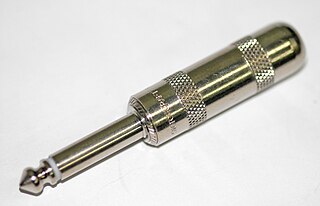
A phone connector, also known as phone jack, audio jack, headphone jack or jack plug, is a family of electrical connectors typically used for analog audio signals. A plug, the "male" connector, is inserted into the jack, the "female" connector.
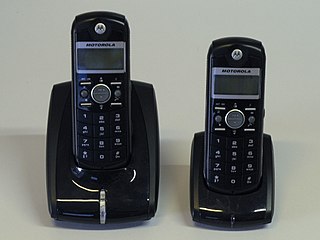
A cordless telephone or portable telephone has a portable telephone handset that connects by radio to a base station connected to the public telephone network. The operational range is limited, usually to the same building or within some short distance from the base station.
Broadcast automation incorporates the use of broadcast programming technology to automate broadcasting operations. Used either at a broadcast network, radio station or a television station, it can run a facility in the absence of a human operator. They can also run in a live assist mode when there are on-air personnel present at the master control, television studio or control room.
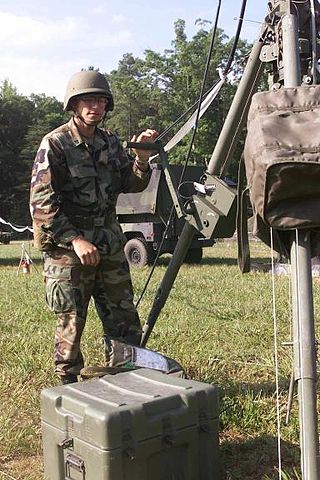
A signaller, signalman, colloquially referred to as a radioman or signaleer in the armed forces is a specialist soldier, sailor or airman responsible for military communications. Signallers, a.k.a. Combat Signallers or signalmen or women, are commonly employed as radio or telephone operators, relaying messages for field commanders at the front line, through a chain of command which includes field headquarters. Messages are transmitted and received via a communications infrastructure comprising fixed and mobile installations.

Field telephones are telephones used for military communications. They can draw power from their own battery, from a telephone exchange, or from an external power source. Some need no battery, being sound-powered telephones.

Asymmetric digital subscriber line (ADSL) is a type of digital subscriber line (DSL) technology, a data communications technology that enables faster data transmission over copper telephone lines than a conventional voiceband modem can provide. ADSL differs from the less common symmetric digital subscriber line (SDSL). In ADSL, bandwidth and bit rate are said to be asymmetric, meaning greater toward the customer premises (downstream) than the reverse (upstream). Providers usually market ADSL as an Internet access service primarily for downloading content from the Internet, but not for serving content accessed by others.
Pulse-code modulation (PCM) is a method used to digitally represent sampled analog signals. It is the standard form of digital audio in computers, compact discs, digital telephony and other digital audio applications. In a PCM stream, the amplitude of the analog signal is sampled at uniform intervals, and each sample is quantized to the nearest value within a range of digital steps.

A telephone exchange, telephone switch, or central office is a telecommunications system used in the public switched telephone network (PSTN) or in large enterprises. It interconnects telephone subscriber lines or virtual circuits of digital systems to establish telephone calls between subscribers.
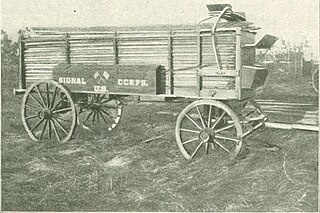
The K-2 Lance wagon is a light wagon approximately 14 ft long, equipped with a high box body running its entire length, the body surmounted in front by a driver's seat; tool and supply containers are attached to either side of the box; proper re-enforcements are provided and suitable brakes are attached; rear wheel diameter 4 ft 8 in; gauge 4 ft 10 in; height of box body 3 ft 9 in; width of box body 3 ft 4 in.

The K-3 cart is a 2-wheel, strongly constructed wire cart, similar to artillery caissons, but equipped for carrying and reeling out wire; used together with Signal cart, type K-4, to form the wagon formerly called "Pintle wire wagon, model 1910."

The K-4 cart is a 2-wheel strongly constructed signal cart similar to artillery caissons, but equipped for carrying signal equipment; used with the Wire cart, type K-3, to form the wagon formerly called "Pintle wire wagon, M1910".
The K-8 cart was a two-wheel horse-drawn cart used by the U.S. Signal Corps, designed for transporting in the field a large assortment of signalling equipment in the field. The cart's gauge is 5 ft 2 in, the wheel rims 2+1⁄2 inches wide, and the wheel diameters are 5 ft. The body of the cart consists of a large chest surmounted by a driver's seat which is 44 inches wide, 27 inches high, and 5 ft 4 in long. It is mounted upon commercial wagon springs, and the interior is equipped with partitions suitably arranged for separating and holding rigidly in place the parts of equipment, type SE-6.

The K-5 truck is a light automobile truck with a 10 feet 4 inches (3.15 m) wheelbase, standard automobile gauge, and 35 in (89 cm) wheels; length from front of radiator to rear of body 15 feet (4.57 m); equipped with single top; formerly marked with the Signal Corps emblem and the words "Signal Corps, U.S. Army" and also with the name "Maintenance truck No.5" or "Tender for radio tractor No.3".
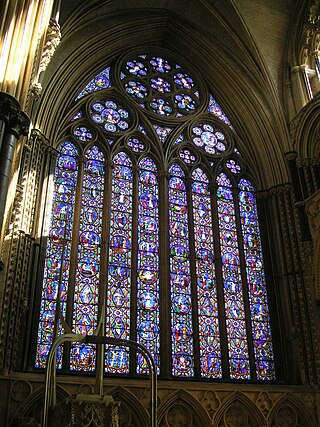
James Henry Nixon (1802–1857) was an illustrator and painter during the Victorian period, who worked in the firm Ward and Nixon painting stained glass windows. James Henry Nixon was a protégé of Charles Winston, who praised Nixon's work at Westminster Abbey and Church of Christ the King, Bloomsbury. The company Ward and Nixon was followed by Ward and Hughes.














